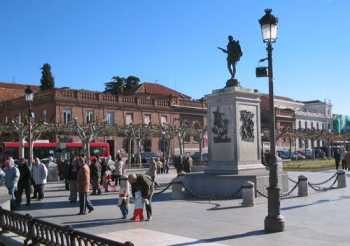Alcalá de Henares: World Heritage City
Just 30 kms from Madrid, Alcalá de Henares has a history which dates back thousands of years
This city 30 kilometres northeast of the Spanish capital, Madrid, has a history dating back thousands of years to the first human settlements which appeared in the area towards the end of the Neolithic Period, in around 3,000 BC.

Plaza de Cervantes in Alcalá de Henares - Photo Wikipedia
It was an important centre of population during the Celtiberian period, when it was known as Iplacea,
Refounded as Complutum under the Romans in the first century BC, it became one of the most important cities of the central Iberian peninsula, with 10,000 inhabitants, and its own government institutions. Many archaeological remains have been uncovered from that time, including the remains of the forum, the Basilica thermal spas, a nymphaeum – an Ancient Roman shrine to water nymphs – a marketplace, and a number of villas.
That period was to last for 400 years, until the Roman Empire began to decay and the Visigoths moved in to occupy the Peninsula, and Complutum went into decline.
The Visigoth civilisation gave way to the Moors, who invaded the Iberian peninsula in 711 AD. They founded another site near Complutum, building the castle of Al-Qal’at en Nahar on a nearby hill: it is known today as Alcalá la Vieja (Old Alcalá).
The city was reconquered for Castile in 1118 by the Archbishop of Toledo, Bernardo de Sadirac, and the Kingdom of Castile ceded Alcalá and its lands to the Archbishopric of Toledo. The city was moved back to the original Roman site, and Alcalá remained in Christian hands throughout the rest of the Moorish occupation.
It was the Toledo Archbishops who were responsible for fortifying and walling the city, and beginning construction in the thirteenth century of the impressive Archbishop’s Palace which still stands today.
The Palace was to be the scene of the first audience given to Christopher Columbus by the Catholic Queen, Isabella, in the late fifteenth century, and was also the birthplace of Ferdinand of Austria and of Catalina of Aragón.
The next period in the city’s history was the Golden Age, which started for Alcalá in 1495 when Cardinal Cisneros was appointed Archbishop of Toledo, and decided to found the university, the Universidad Complutense, and began a process of urban renewal to create the first model university town of the Modern Age. The university opened its doors in 1508 to students and was soon flourishing as a renowned centre of learning.
UNESCO said in its 1998 declaration granting World Heritage Site status to the university and historic city centre, that ‘Alcalá de Henares was the first city to be designed and built solely as the seat of a university, and was to serve as the model for other centres of learning in Europe and the Americas.’
Other criteria justifying its inscription on the World Heritage List were given as the concept of the ideal city (Civitas Dei, or the City of God) which saw its first material expression in Alcalá, and in the linguistic advances which took place here, ‘in the definition of the Spanish language, and through the work of its great son, Miguel de Cervantes Saavedra’ (born in Alcalá de Henares in the mid 16th century) ‘and his masterpiece, Don Quixote.’
Complutense was moved to Madrid in 1837 (known now as the Universidad Complutense de Madrid), and the university in Alcalá was not to reopen until 1977, with the name of the University of Alcalá de Henares.
Today, the prestigious awards in the Miguel de Cervantes Prize for outstanding achievements in Spanish-language literature are presented in the author’s birthplace, with the awards made in the University itself by the King and Queen of Spain.
And in 1991, Alcalá de Henares was chosen as the headquarters of a non-profit organisation created by the Spanish government and named after Alcalá’s most famous son: now worldwide, the Cervantes Institute aims to promote Spanish language teaching and knowledge of the cultures of the Spanish-speaking countries throughout the world.
